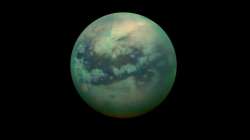NASA’s Cassini spots mysterious ice cloud over Saturn's moon Titan
In a revelation that goes contrary the understanding scientists had of the atmosphere of Saturn’s largest moon so far, NASA's Cassini spacecraft has found an outlandish mysterious ice cloud over Titan. "The appearance of

In a revelation that goes contrary the understanding scientists had of the atmosphere of Saturn’s largest moon so far, NASA's Cassini spacecraft has found an outlandish mysterious ice cloud over Titan.
"The appearance of this ice cloud goes against everything we know about the way clouds form on Titan," said lead author of the study Carrie Anderson from NASA's Goddard Space Flight Center in Greenbelt, Maryland.
The puzzling appearance of the ice cloud has prompted Nasa scientists to suggest that a different process than previously thought - possibly similar to one seen over Earth's poles - could be forming the clouds.
Located in Titan's stratosphere, the cloud is made of a compound of carbon and nitrogen known as dicyanoacetylene, an ingredient in the chemical cocktail that colours the giant moon's hazy, brownish-orange atmosphere.
And it is not the first time NASA scientists spotted the mysterious cloud.
Decades ago, the infrared instrument on NASA's Voyager 1 spacecraft spotted an ice cloud just like this one on Titan.
What has puzzled scientists ever since is this: they detected less than one percent of the dicyanoacetylene gas needed for the cloud to condense.
Recent observations from NASA's Cassini mission yielded a similar result. Using Cassini's composite infrared spectrometer, or CIRS -- which can identify the spectral fingerprints of individual chemicals in the atmospheric brew -- researchers found a large, high-altitude cloud made of the same frozen chemical.
Yet, just as Voyager found, when it comes to the vapour form of this chemical, CIRS reported that Titan's stratosphere is as dry as a desert.
The puzzling appearance of the ice cloud seemingly out of thin air prompted the scientists to suggest that a different process than previously thought -- possibly similar to one seen over Earth's poles -- could be forming clouds on Saturn's moon Titan.
Although Earth's stratosphere has scant moisture, wispy nacreous clouds (also called polar stratospheric clouds) can form under the right conditions.
In these clouds, chlorine-bearing chemicals that have entered the atmosphere as pollution stick to crystals of water ice, resulting in chemical reactions that release ozone-destroying chlorine molecules.
"It's very exciting to think that we may have found examples of similar solid-state chemical processes on both Titan and Earth," Anderson, a CIRS co-investigator, said.
The study was published in the journal Geophysical Research Letters.
(With inputs from IANS)